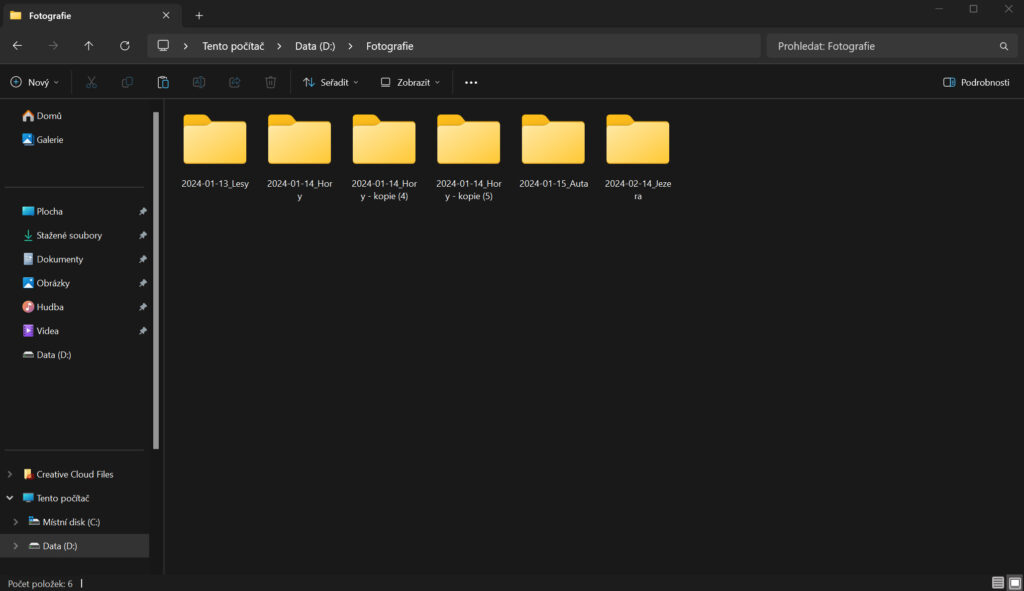How to effectively organize photographs: Comparison of options for individuals and teams [2025]

In today’s digital age, we take more and more photographs – whether for personal purposes, such as holiday snapshots or photos of our pets, but also for professional purposes. Organizations often produce a large number of photographs from various events, which can later serve, for example, for their promotion. For effective management of these photographs, it is ideal to have an archive in one place, in which we will be able to easily retrieve images by various topics and events afterward, without spending a great deal of time on it. The right choice of such a solution allows us to devote time and effort to more important things than searching for photos. In this article, we will introduce some of the current options for effective photo organization.
1. Storing Photos on a Hard Drive
Storing photos locally on your computer or on a hard drive is the first and simplest option that probably comes to mind. It is a cost-effective solution, allowing you to easily create folders, for example by event or date taken. However, in order to prevent chaos from arising in such an archive, you need to adhere to the rules you set for yourself. As the number of folders grows, you lose track and it becomes increasingly difficult to find photos from individual events. Finding a specific photo or photos by a certain topic then becomes virtually impossible.
Advantages:
- 💚 Low costs – You only need to purchase a hard drive of the required size, which is a one-time investment that isn’t very large today.
- 💚 Easy copying and moving – Entire folders can be simply transferred or backed up, which does not require extensive knowledge.
- 💚 Local data storage – Data is stored directly with you, ensuring fast access without the need for an internet connection.
Disadvantages:
- ❌ Risk of data loss – Storing data only locally on your computer or on a hard drive can lead to its loss in case of disk failure. If you don’t have another backup, those photos are gone forever.
- ❌ Backups increase costs – If you want to back up the data, you need additional local storage, which leads to further investment.
- ❌ Unsuitability of USB flash drives and memory cards – These media are not ideal for long-term storage of large volumes of photos; they are prone to physical damage and loss.
- ❌ Unsuitable for team collaboration – This method of organization is ideal for individuals, but when working in a team it can lead to issues with synchronization, access permissions, and data consistency. Sharing and managing folders among multiple users can be complicated and error-prone.
- ❌ Advanced protection requires more complex solutions – To increase data security, you need to use more advanced methods such as RAID, which allows the configuration of multiple drives for basic failure protection and increased reliability of stored data.
This basic folder-based organization method is suitable for individuals due to its simplicity and low cost. However, to ensure the long-term security of your data, it is important to combine it with regular backups and possibly invest in more advanced protective solutions.

2. Cloud Storage (Google Drive, OneDrive, Dropbox, etc.)
Another option is to use cloud storage services like Google Drive, OneDrive, or Dropbox. These solutions allow you to store photos and other data online, meaning you have your files available from anywhere with an internet connection. You can also easily share your photos with others, which is ideal for team collaboration or sharing memories with family and friends. The downside is, again, the need to maintain folder-organization rules and the potential loss of oversight when dealing with a large number of photos.
Advantages:
- 💚 Available from anywhere – You can access your data from any device with an internet connection, providing flexibility and convenience.
- 💚 Basic sharing options – Allows easy sharing of files and folders with other users, facilitating collaboration.
- 💚 Protection against data loss – Data is stored on remote servers, guarding against loss in case of local-drive failure.
- 💚 Automatic synchronization – Changes made on one device automatically appear on all others, ensuring your data stays up to date.
- 💚 Scalable storage – You can easily expand storage capacity as needed without purchasing new hardware.
Disadvantages:
- ❌ Limited organization tools – Cloud storage typically provides only basic folder structures without advanced photo-search, tagging, or bulk metadata-editing features.
- ❌ Reliance on an internet connection – An active connection is required for proper syncing of photos or other files.
- ❌ Higher costs – Premium plans with larger storage allowances can be expensive, especially for users with large data volumes.
- ❌ Compatibility and integration – Some cloud services may not fully integrate with certain software tools or devices, which can limit their usefulness.
Cloud storage services such as Google Drive, OneDrive, or Dropbox represent a similar variant to basic folder organization on a local drive, but with the difference that data is stored in the cloud. This approach offers advantages in terms of availability and easy sharing, but lacks advanced search features. For users who need more comprehensive management and organization of their data, cloud storage may be less suitable.

3. Infiry
Infiry is a web application designed for advanced management and organization of photographs. It combines cloud storage features with tools for detailed description, searching, and sharing of images. It thus allows not only storing photos on remote servers but also assigning metadata to them, generating keywords using artificial intelligence, and facilitating team collaboration.
Advantages:
- 💚 Detailed descriptions and AI keywords – To each photograph you can add a description, license, keywords, author, or date and time taken. This data can also be copied to all other photos currently being uploaded, so you can save time describing a large number of photos. At the same time, artificial intelligence automatically saves appropriate keywords, which significantly improves later photo searching.
- 💚 Advanced searching and filtering – Thanks to rich metadata and AI tools, you can filter photos by author, dominant color, location, license, and other parameters. Searching here works similarly to, for example, Google Search, where you enter what you are looking for and your photos are displayed accordingly.
- 💚 Easy sharing and team collaboration – Photos are uploaded once and then you can share them arbitrarily within the team or with external collaborators. Everyone always has access to the most up-to-date versions. Only you decide who has access to your photos.
- 💚 Organization into collections and departments – For clarity, you can sort images into special collections and departments (e.g., by client, event, or project).
- 💚 Automatic generation of photo variants – Infiry can create versions optimized for web or watermarked variants of photos automatically, without the need for time-consuming edits.
- 💚 Available from anywhere – Infiry is a cloud service that you can connect to from any device.
- 💚 Plan flexibility – In Infiry you can change your current plan at any time according to your needs – whether you need more users or greater storage.
Disadvantages:
- ❌ Dependency on the internet – As with other cloud solutions, an internet connection is necessary to access photographs.
- ❌ Potential costs – When storing a large amount of data, subscription costs may be higher than with basic cloud solutions or local drives.

Conclusion
Effective management of photographs today depends not only on how they are stored but also on the options for searching and sharing them. If a simple folder structure suffices and you’re not looking for advanced features, you can use local storage on a hard drive. If you prefer remote access and team sharing, cloud solutions like Google Drive, OneDrive, or Dropbox will serve you well. However, if you work with a larger volume of images or need to add metadata, keywords, and use advanced search functions, Infiry may be a more suitable choice for you. It offers more detailed organization, automatic AI-powered keyword suggestions, and still retains the benefits of cloud storage. Whatever you decide, the most important thing is to choose a solution that best matches your needs and makes your work easier.
Tags:
- Infiry
- Photo management
- Photo organization
- Tips
